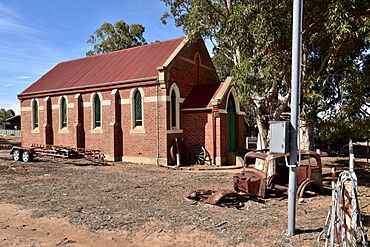Dangin, Western Australia facts for kids
Quick facts for kids DanginWestern Australia |
|
|---|---|

The former Dangin Methodist Church, 2018
|
|
| Established | 1902 |
| Postcode(s) | 6383 |
| Elevation | 259 m (850 ft) |
| Area | [convert: needs a number] |
| Location |
|
| LGA(s) | Shire of Quairading |
| State electorate(s) | Central Wheatbelt |
| Federal Division(s) | O'Connor |
Dangin is a small town located in the Wheatbelt area of Western Australia. It is about 7.7 kilometers (4.8 miles) west-south-west of Quairading. In 2006, 283 people lived in Dangin.
The town of Dangin gets its name from a nearby place called Dangin Spring. It is believed that this name comes from an Australian Aboriginal word. It might mean "place where the Djanja grows." The Djanja is a type of Hakea plant found in the area. The name was first written down in 1863. It was the name of a farm owned by Edward Read Parker. His father was the first European settler in this region.
How Dangin Started
Around 1900, Jonah Parker, Edward's son, owned the land. He started dividing his property into smaller pieces. This allowed people to build homes and create an unofficial town. The town was officially recognized in 1902. However, Jonah Parker still owned all the land around it. This made it hard for people to get into the town. At first, selling alcohol was not allowed in Dangin. But there was a "temperance hotel" that offered hospitality without serving drinks.
By 1908, the town of Quairading was connected by a railway. Quairading was also officially made a town. After the railway arrived, Quairading got more facilities. These included a regular hotel. Quairading was also a bit closer to the shared water supply at Toapin Weir.
By the early 2000s, only a few houses were left in Dangin. Quairading had become the main town in the area.
The Dangin Gate Dispute
In the 1910s, the Parker family set aside some of their farm land for a schoolhouse. But in 1912, a teacher wrote to the Department of Education. The teacher complained that the Parkers were threatening to keep a gate locked. This gate was in a fence that went through the town. People using the gate were leaving it open, which put Parker's crops at risk. But keeping the gate locked made it hard for people to get into Dangin.
This problem led to the townspeople asking the government for help. They wanted the government to take over the town. However, after a public meeting, the local taxpayers changed their minds. Parker then suggested fencing off certain roads into town. He would also fence the town area and remove the gate. This idea was rejected because it would cost too much.
In October 1912, the local board removed the gate. This meant Parker's land was now open to cattle. Parker then offered to pay for the gate to be closed at night if it could be left open during the day. This offer was refused.
The dispute continued for some time. Eventually, the court decided that the board was wrong to remove the gate. The board had to pay the Parkers some money. After this, most of the board members responsible were removed from their positions.
Land for Soldiers
In 1920, the government department that helped soldiers returning from war was looking for large land areas. They wanted to create farms for these soldiers. The Parker estate was seen as a perfect place. The property was divided into 19 lots. The 22 soldiers who were chosen received money each day to help them get started. They leased the land for 25 years.
The Parker estate was very attractive because it had a reliable water supply. The Parkers had built the Toapin Weir. This helped ensure a steady water supply for the growing community and farming industry. Having a constant water supply was very important. The Parker family had the means and determination to make this happen.


